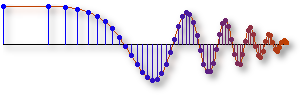
9. Continuous-Time Signals and LTI Systems
We began this text with an introduction to continuous time
signals and systems, and now we are going to return
to that topic. While discrete-time systems have many
virtues and we have emphasized them up this point, it
is generally impossible to avoid some consideration of
continuous-time signals and systems since most signals
originate in continuous-time form.
In this chapter, we will begin with a review
of our earlier discussion of continuous-time sinusoidal
signals and then introduce several other basic signals
that are important in the study of continuous-time
systems. We will review the concepts of linearity
and time-invariance and introduce the convolution
representation of linear time-invariant systems. As part
of our discussion, we will introduce the unit-impulse
signal, which in the continuous-time case is a very
strange, but very useful, mathematical concept. This
concept is necessary to define the impulse response for
LTI systems, which in turn leads to the concept of
continuous-time convolution.
| Lab 12: Two Convolution GUIs |
This lab concentrates on the use of two MATLAB GUIs for convolution.
- dconvdemo: GUI for discrete-time convolution.
This is exactly the same as the MATLAB functions
conv() and firfilt() used to implement FIR filters.
- cconvdemo: GUI for continuous-time convolution.
Each one of these demos illustrates an important point about the
behavior of a linear, time-invariant (LTI)
system. They also provide a convenient way to visualize
the output of a LTI system.
|

